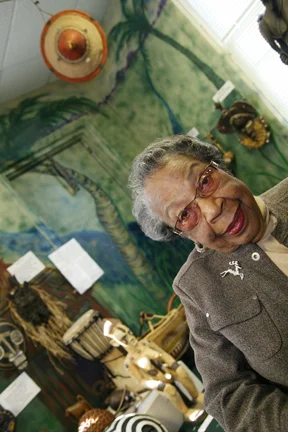Hana Lee Stith, Educator At Rest and Remembered

Dearly Departed Stith Co-founded Fort Wayne’s African-American Museum
Written by William Bryant Rozier
Educator and mentor Hana Lee (Bryant) Stith, born August 12, 1928, passed on September 5, 2018, and was buried on September 15. The funeral was held at Pilgrim Baptist Church, but she was a lifelong member of Turner Chapel AME, whose pastor, Kenneth Christmon, performed the call to worship.
Patsy Brewer first met Hana Stith during a planning meeting for the African/African-American Historical Society & Museum (AAAHSM) at 436 East Douglas Avenue because she disbelieved “little ole Fort Wayne” was getting its own black museum, like a big city.
Stith co-founded the museum with her husband, Harold, after a 36 year teaching career, including a 14-year stint as a Title 1 Math and Reading teacher, to those who needed assistance the most of all.
One of the first to encourage Stith to open an African-American museum was a co-worker at the Lincoln Museum, where Stith worked as a docent. She was also on the Executive Board of the NAACP.
The museum meeting happened during Brewer’s first week back in Fort Wayne after a twenty-year break; she was the mom of four little kids. All of her children are today college graduates. Stith paid for Brewer’s second oldest to take the Praxis test for teaching certification when he couldn’t afford it; he is now a fifth grade teacher. When Brewer’s oldest went on a mission trip, Stith gave her money for that.
“She was loving, caring, and friendly,” Brewer said. “When she was talking with you she made you feel like you were the only person in the world.” And Brewer said Smith was always so proud of the accomplishments of African-Americans, whether you were a valedictorian, a doctor, lawyer, or a teacher.
“She always said when the opportunity [for education] presented itself, you have to take it,” Brewer said. It was Stith, along with her best friend Jackie Patterson, that pushed Brewer to go back to school, and to eventually graduate with honors from Ivy Tech.
Back at that first AAAHSM meeting, Brewer began volunteering for Stith; Brewer’s first act was to help Stith decorate an African-American tree at the Embassy’s Festival of Trees.
Two years later, she accepted a staff position at the AAAHSM and held it until she left to work at the Allen County Township Trustee’s office in 2011, where she’s employed as the trustee’s Executive Secretary. Patterson, Lola Curry-Bates, and Rubin Brown also came to work at the museum in various positions.
According to Brewer, most of the museum’s artifacts were already in Stith’s personal collection; some were gifted, like Ian and Mimi Rolland’s books from Africa. There were always books around the museum for kids. Children books resting on a little kid table is the first thing one sees when looking into the AAAHSM’s library room today.
“She loved children,” Brewer said. “She wanted to have more but only had one, her daughter Robin.”
Stith always collected; she once showed Brewer her pristine-looking report cards from Study Elementary and her graduation announcements from Central High School, Class of 1946, still wrapped in the little tissue paper that came with it.
Central High School, the city’s first high school, was an early adopter of integrated education. But the black students, Stith included, were made to enter through a side door at the school that’s now Anthis Career Center, Brewer recalled being told.
Stith knew Johnny Bright, arguably the G.O.A.T. of Indiana high school sports, and was at the school when Central won a state championship in basketball with lone black player Jim Banks.
When the museum opened (February 1, 2000), it became a hub of activity; if there wasn’t a tour from the FWCS on site, there were mobile exhibits and presentations that Stith, Brewer, and Dan Jones, Hana’s brother, gave. And folks popped in to ask Stith for help, like starting a new business (she made calls), scraping together some money for a greyhound ticket. When one of Mr. Stith’s boxers wanted to look good leaving jail, Stith bought him a suit.
The museum stayed busy with constant tours, and Stith kept occupied with side projects connected to it. The museum helped rename Section 19 of Lindenwood Cemetery, where a lot of black people were buried, Jordan’s Crossing, as in crossing over into the Jordan River. Stith and Brewer even trekked to Fishers, Indiana, and learned how to clean and restore grave markers.
“We got a history lesson every day,” Brewer said.
Stith collected a thick paragraph full of accomplishments and awards, including the Zeta Phi Beta Woman of the Year (1983), City of Fort Wayne Black Expo achiever of the Year (1991), the MLK Jr. Club Community Service Award (1996), Saint Francis Alumni Distinguished Alumni Award (2005), the State of Indiana Sagamore of the Wabash Award (2005), and the Fort Wayne Journal Gazette Citizen of the Year (2006). There were more accolades; they came from all directions.
Stith was a friend, educator, and mentor to many. “She loved people. Love is an action word, and she showed it.”

